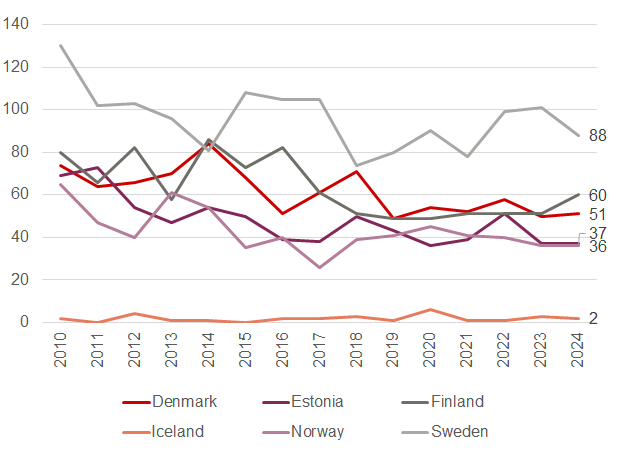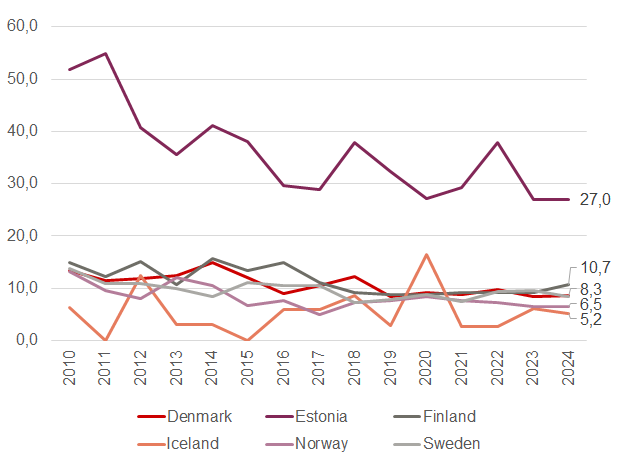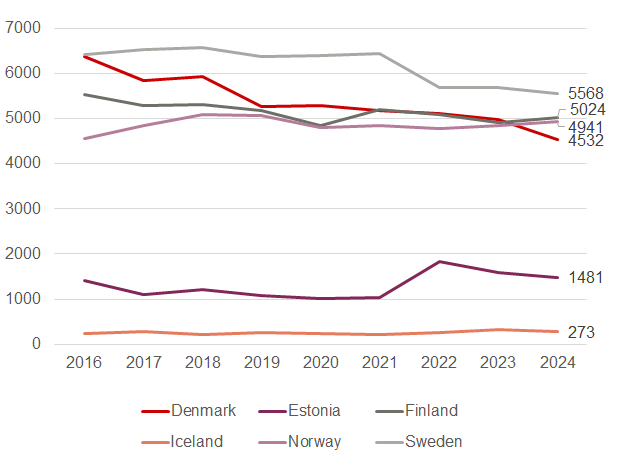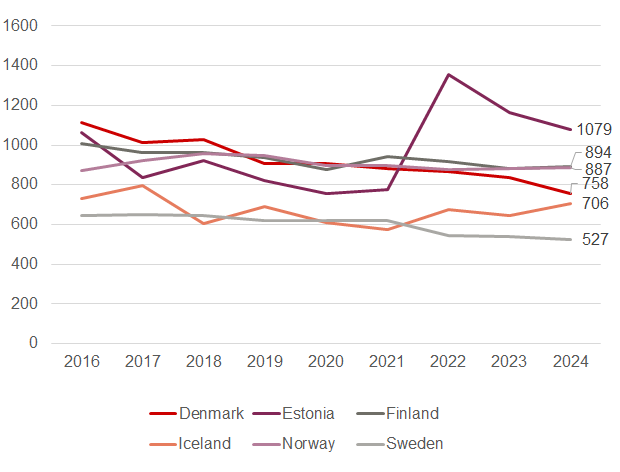Nordic Fire Statistics
The purpose of Nordic Fire Statistics is to provide statistics on fire deaths and building fires which are of sufficient quality to allow a comparison of the fire problem across the Nordic countries and Estonia.
On this page
Nordic Fire Statistics – a work in progress
Statistics on fire deaths and building fires in the Nordic countries have been published on this website for several years. It is now time to revise the contents and publish statistics in a new way.
For a short period, this site will have some basic statistics covering the most recent years for which data has been compiled. More statistics will become available when the participating countries have agreed on definitions for the new content and provided updated data sets.
Fire deaths
In recent years, Denmark, Finland, Norway, and Sweden have experienced a broadly similar level of fire deaths measured as a yearly rate per million population. The level of fire deaths is lower in Iceland, and higher in Estonia.
-
Statistics on fire deaths
The central authorities in the participating countries follow up all fire deaths that come to their knowledge. If relevant information is available, they make an assessment about the location and cause of the fire, and how the fire has led to the fatal injuries sustained by the fire victims.
To be included in these statistics, the fire authority must assess that the death has occurred within 30 days due to injuries sustained in a fire (most often burns or the toxic effects of smoke).
Fire deaths per year 2010 – 2024

Fire deaths per year and country
Fire deaths per year 2010 – 2024 (Excel)
When comparing countries, it is relevant to relate the number of fire deaths to the population in each country. The diagram below shows the yearly rate per million population. It is interesting to note that in recent years, Denmark, Finland, Norway, and Sweden have experienced a broadly similar level of fire deaths.
The level of fire deaths is lower in Iceland, but they have a relatively low population and there are often years when no fire deaths occur. The death rate due to fire is substantially higher in Estonia, but politicians have agreed on the goal of reducing this to the level of the Nordic countries, and the current level is far lower than in 2010.
Fire deaths per million population 2010 – 2024

Fire deaths per million population 2010 – 2024
Fire deaths per million population 2010 – 2024 (Excel)
Fire deaths by scene of fire, yearly average 2010 – 2024
Scene Denmark Estonia Finland Norway Sweden Block of flats 20,8 18,5 15,1 9,7 36,5 House 24,9 21,1 32,1 22,5 38,5 Summerhouse 1,3 2,3 3,7 1,9 3,3 Health and social services 7,5 1,0 0,5 2,3 4,1 Other building 3,6 3,5 3,2 2,9 3,0 Road vehicles 1,5 0,2 3,2 0,9 6,3 Other outdoor 1,2 1,2 2,1 2,7 4,1 Unknown outdoor 0,7 0,0 0,1 0,1 0,1 Figures for Iceland will be provided when the contents of this website are revised.
Fire deaths by month of fire, yearly average 2010 – 2024
Month Denmark Estonia Finland Norway Sweden January 7,3 5,4 7,5 6,2 12,0 February 5,3 6,4 5,7 3,7 8,9 March 6,6 5,1 5,2 4,2 8,4 April 5,7 4,1 5,2 3,7 8,0 May 5,3 3,7 5,4 2,5 9,1 June 3,9 1,7 3,1 2,3 6,1 July 2,7 1,5 2,2 2,6 4,9 August 2,9 1,3 3,5 2,3 3,9 September 3,9 2,5 4,9 ,5 5,7 October 4,6 4,3 5,4 3,4 7,7 November 6,3 3,7 6,1 3,7 9,1 December 7,0 8,2 5,8 6,0 12,3 Figures for Iceland will be provided when the contents of this website are revised.
Building fires
In recent years the yearly rate of building fires in the Nordic countries and Estonia has ranged between 600 and 1100 fires per million population.
-
Statistics on building fires
These statistics concern building fires which the fire and rescue service have been called to, and which are assessed by the fire and rescue service to have caused injury or damage to property.
All the participating countries present statistics for various kinds of buildings, but the categories are not always comparable, in particular for non-residential buildings. Unfortunately, the only way to present comparable statistics is to group all non-residential buildings together in a single category.
Building fires per year 2016 – 2024

Building fires per year 2016 – 2024
Building fires per year 2016 – 2024 (Excel)
Building fires per million population 2016 – 2024

Building fires per million population 2016 – 2024
Building fires per million population 2016 – 2024 (Excel)
Building fires by category, yearly average 2016 – 2024
Category Denmark Estonia Finland Norway Sweden Block of flats 908 452 1 113 1 256 1763 House 1 668 298 1 356 1818 1695 Summerhouse 133 54 140 136 187 Other building 2 686 502 1 969 1660 2550 Figures for Iceland will be provided when the contents of this website are revised.
Building fires by month, yearly average 2016 – 2024
Month Denmark Estonia Finland Norway Sweden January 522 130 420 443 561 February 415 101 330 357 470 March 452 106 359 396 513 April 495 117 375 419 539 May 499 127 436 428 577 June 468 121 428 397 530 July 413 106 395 376 499 August 401 104 385 390 491 September 392 97 359 398 463 October 386 94 351 409 486 November 405 92 357 395 480 December 547 113 386 462 585 Figures for Iceland will be provided when the contents of this website are revised.
About Nordic Fire Statistics
The central fire authorities in the Nordic countries all produce fire statistics based on data collected from their fire and rescue services.
Twenty years ago, the directors general for the central fire authorities in the Nordic countries agreed to initiate a collaboration on fire statistics. The aim was to improve the comparability in the fire statistics produced in the various countries, to compare emerging trends and to learn from each other about methods for statistical analysis to better inform the work of fire prevention.
Politicians in Estonia have agreed on the goal of reducing their level of fire deaths to that of the Nordic countries, and Estonia has therefore joined this collaboration to ensure the quality of their benchmarking with Nordic colleagues.
As a result of this cooperation on fire statistics, it is possible to provide statistics on fire deaths and building fires which are of sufficient quality to allow a very basic comparison of the fire problem across the Nordic countries and Estonia.
Contacts
This website is hosted by the Swedish Civil Contingencies Agency (MSB). If you have general questions concerning the statistics or how we have chosen to publish them on this website, you are welcome to contact us in Sweden. For questions relating to the figures from a specific country, it is more appropriate to get in touch with that country, as they will have a fuller understanding of how the data has been compiled.
Denmark
Danish Emergency Management Agency (Beredskabsstyrelsen)
General website: www.brs.dkStatistics website: statistikbank.brs.dk/Britt Løwe Nyborg: brs-bln@brs.dk
Steen Hjere Nonnemann: brs-shn@brs.dk
Estonia
Estonian Rescue Board (Päästeamet)
General website: www.rescue.ee
Statistics website: www.rescue.ee/et/statistika
Maris Uuetoa: maris.uuetoa@rescue.ee
Oleg Morozov: oleg.morozov@rescue.ee
Finland
Emergency Services Academy (Pelastusopisto)
Statistics website: pelastustoimi.fi/en/rescue-services/statistics
Heidi Liukkonen: heidi.liukkonen@pelastusopisto.fi
Timo Loponen: timo.loponen@pelastusopisto.fi
Ministry of the Interior (Sisäministeriö)
Tiina Etelälahti: tiina.etalalahti@gov.fi
Wellbeing Services County Company Hyvil Oy (Hyvinvointialueyhtiö Hyvil Oy)
Esa Kokki: esa.kokki@hyvil.fi
Iceland
Housing and Construction Authority (Húsnæðis- og mannvirkjastofnun)
Grétar Þór Þorsteinsson: gretar.thorsteinsson@hms.is
Norway
Norwegian Directorate for Civil Protection (Direktoratet for samfunnssikkerhet og beredskap)
Statistics website: www.dsb.no/menyartikler/statistikk/
Reidun Mo: reidun.mo@dsb.no
Vidar Falkenberg: vidar.falkenberg@dsb.no
Sweden
Swedish Civil Contingencies Agency (Myndigheten för samhällsskydd och beredskap, MSB)
Statistics website: www.msb.se/statistik
Colin McIntyre: colin.mcintyre@msb.se
Joakim Ekberg: joakim.ekberg@msb.se
